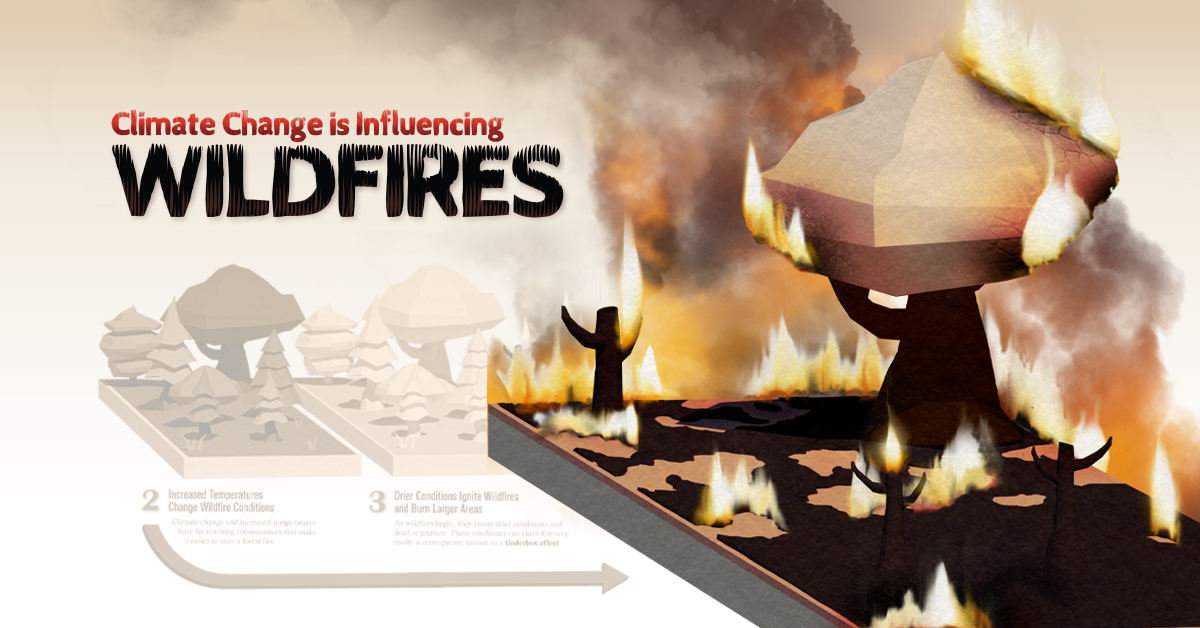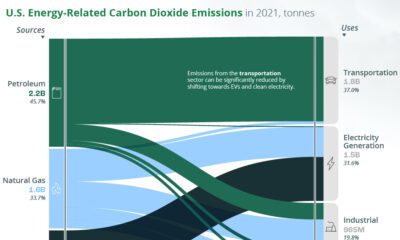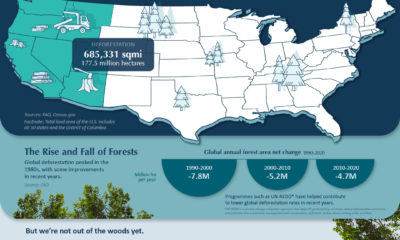Environment
Explained: The Relationship Between Climate Change and Wildfires
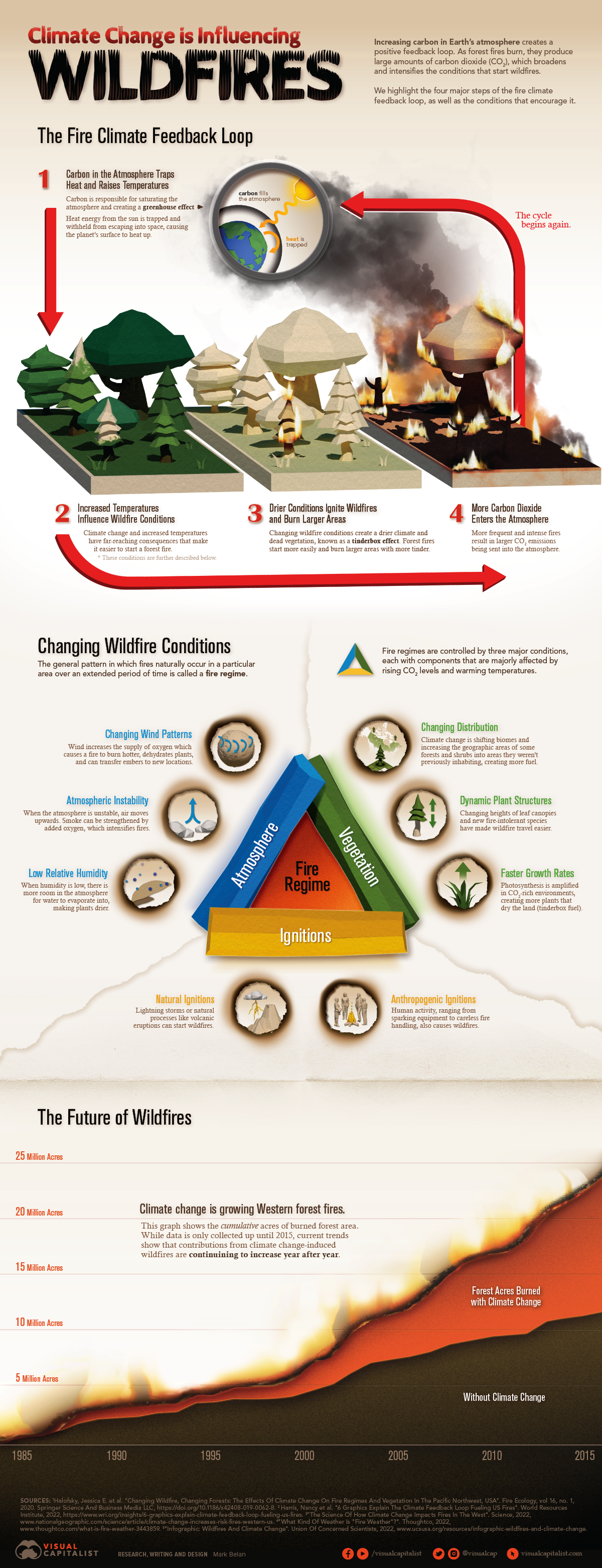
How Climate Change is Influencing Wildfires
Each year, thousands of wildfires burn through millions of acres of land around the world.
We’ve already seen the mass devastation that wildfires can bring, especially in places like Australia, Serbia, and California. But new research by the UN indicates that things might get even worse by the end of the century. By 2100, the frequency of wildfires could increase by up to 50%.
What’s causing this influx of wildfires around the world? Below, we dig into how climate change is impacting wildfires—and how in turn, wildfires are impacting climate change.
Climate Conditions That Support Wildfires
Before diving in, it’s worth going over the basics of wildfires, and how they get started in the first place. An area’s vulnerability to wildfires, also known as its fire regime, depends on three major conditions: its atmosphere, vegetation, and ignitions.
① Atmosphere
Atmosphere plays a big part in how sensitive an area is to wildfires. For instance, wind can increase oxygen supply in an area, which would help fuel a wildfire, and may even transfer embers to new locations.
② Vegetation
Vegetation is also a huge factor in whether or not an area is vulnerable to wildfires. A region with drier vegetation may catch fire more easily, and an area with more forest or shrubs provides more fuel for potential blazes.
③ Ignitions
An area that’s close to volcanic activity, or prone to lightning storms may be more susceptible to wildfires. However, human activity like campfires or faulty equipment can also trigger fires, so popular areas for camping or logging may be at higher risk as well.
While these conditions vary depending on the location, in general, fire regimes are being impacted by climate change, which is causing an influx in the duration and intensity of wildfires around the world.
The Fire Climate Feedback Loop
Since the 1850s, global surface temperatures have risen by about 1.0°C (1.8°F).
These increased surface temperatures have had far-reaching impacts on our climate—in the Northern Hemisphere, warmer temperatures have led to less snow, earlier arrival of spring, and ultimately longer, drier fire seasons.
These longer fire seasons have led to an influx of wildfires. But here’s the kicker—wildfires emit tons of carbon. In 2021, wildfires around the world emitted an estimated 1.76 billion tonnes of carbon into the atmosphere, which for context, is more than double the annual emissions from the entire country of Germany.
This carbon gets trapped in our atmosphere and contributes to rising surface temperatures. In other words, more carbon creates more wildfires—and more wildfires create more carbon.
Extreme Weather Events Are Rising In General
It’s not just wildfires that are growing in frequency and intensity because of climate change—droughts, heatwaves, and floods are also becoming more common around the world.
This year, temperatures reached all-time highs across Europe, which wrecked havoc across the continent, impacted infrastructure, and even took lives.
Experts warn that this may become the new normal. To help mitigate risk, governments, policymakers, and companies need to band together to create safeguards and establish proper preventative measures.
Environment
3 Ways the Shipping Industry is Addressing Climate Change
The shipping industry is responsible for 2.89% of all carbon emissions. Here are three ways it could evolve to address climate change.
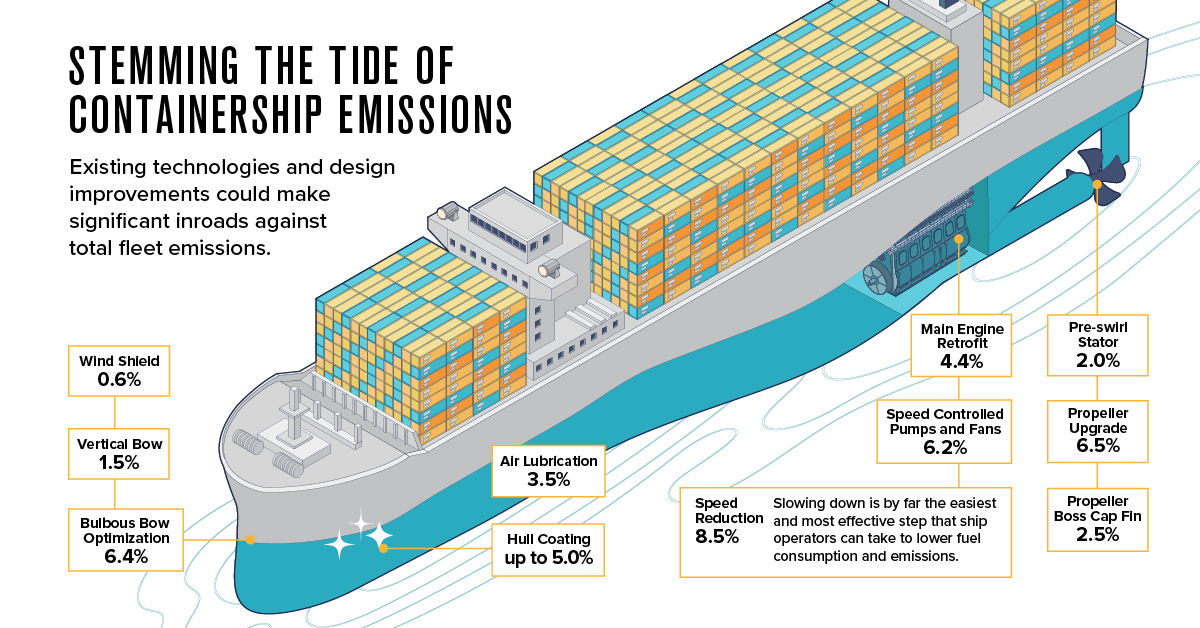
3 Ways the Shipping Industry is Addressing Climate Change
The global shipping industry is on the verge of a transformation not seen since the transition from sail to steam.
In 2018, the industry emitted 1.1 billion metric tons of greenhouse gas emissions, representing 2.89% of all anthropogenic, or human-caused, emissions. And according to the International Maritime Organization (IMO) that could increase 90-130% in 2050, from a 2008 baseline.
This is the second and final part of The Shipping Industry: Plotting a Course for the Future, a two-part series from our sponsor Seaspan Corporation, that looks at three ways that containerships in particular, could evolve to become more sustainable.
1. Stemming the Tide of Containership Emissions
Unlike personal transport, which has a proven and commercially scalable technology in electric vehicles, there’s no silver bullet for shipping. However, existing technologies and design improvements could help make significant inroads against total fleet emissions.
According to data from Seaspan, propeller upgrades (6.5%), hull coatings (up to 5.0%), and main engine retrofits (4.4%) won’t bring emissions to zero on their own, but taken together they add up to big savings.
| Technology | Annual Abatement potential |
|---|---|
| Speed reduction | 8.5% |
| Propeller Upgrade | 6.5% |
| Bulbous bow optimization | 6.4% |
| Speed Controlled Pumps and Fans | 6.2% |
| Hull coating | 5.0% (up to) |
| Main engine retrofit | 4.4% |
| Air lubrication | 3.5% |
| Propeller boss cap fin | 2.5% |
| Waste Heat Reduction | 2.2% |
| Pre-swirl stator | 2.0% |
| Weather Routing | 1.7% |
| Autopilot Upgrade | 1.7% |
| Vertical bow | 1.5% |
| Wind shield | 0.6% |
| High-Efficiency Lighting | 0.4% |
Interestingly, the biggest potential impact could come from slowing down ships (8.5%), which lowers fuel consumption and as a consequence, emissions. In the race to net zero, slow and steady could very well win the race.
2. Sailing the Ocean Green
In the long run, though, design tweaks don’t address the elephant seal in the room, which is the industry’s reliance on fossil fuels. Ships that run on alternate fuels, like ammonia, methanol, and even wind-power, are all in development, but many of the technologies are still in the early stages.
To help spur development, a group of countries at COP26, the annual UN climate conference, committed to establishing green shipping corridors where vessels would run on alternate fuels. A total of 24 countries signed the Clydebank Declaration, including the U.S. and the UK, and together they hope to catalyze the shift to zero emission shipping.
3. Leaving Fossil Fuels High and Dry
Many ship owners and operators are looking at Liquid Natural Gas (LNG) as a transitional fuel, while alternate fuel technologies mature. LNG emits between 13.2% and 16.6% less CO2 than conventional bunker fuel oil, a highly viscous residual fuel that is high in sulfur, so it’s no surprise that LNG-powered containerships represent 29.23% of the existing orderbook.
But with all but 2.4% of the current global fleet running on fossil fuels, there is still a long journey ahead.
On the Right Tack
The 1997 Kyoto Protocol established the IMO as the forum for climate change action for the shipping industry, which many have criticized for not moving fast and far enough on climate change.
At the July 2023 meeting of the Marine Environment Protection Committee, the IMO adopted a new greenhouse gas strategy, which set “indicative checkpoints” for emission reductions for 2030 and 2040 in place of binding targets, and committed to hit net zero “by or around, i.e. close to 2050, taking into account different national circumstances.” The IMO also declined to put a price on carbon.
Even without firm targets, many industry players aren’t waiting to move on the climate emergency. Seaspan, the world’s largest independent charter owner and manager of containerships, is moving to green their fleet. They recently signed an agreement to retrofit 15 ships with dual-fuel engines that can also run on green methanol, with an option for 45 more.

Find out what else Seaspan is doing to get ready for the future of shipping.

-
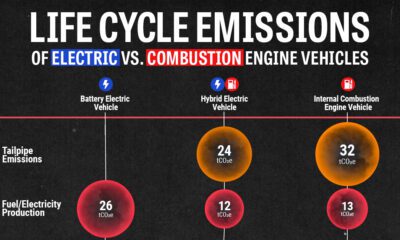
 Energy4 weeks ago
Energy4 weeks agoLife Cycle Emissions: EVs vs. Combustion Engine Vehicles
We look at carbon emissions of electric, hybrid, and combustion engine vehicles through an analysis of their life cycle emissions.
-
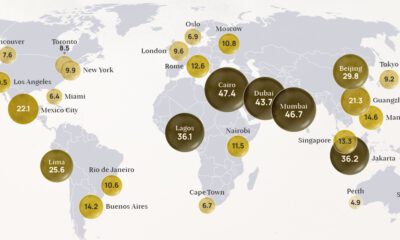
 Green3 months ago
Green3 months agoMapped: Air Pollution Levels Around the World in 2022
Exploring 2022 average air pollution levels around the world by PM2.5 concentration.
-
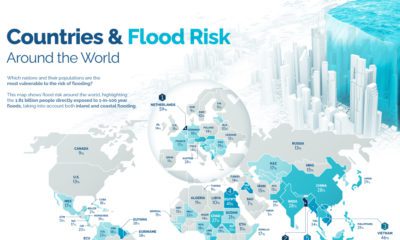
 Water10 months ago
Water10 months agoMapped: Countries With the Highest Flood Risk
Recent floods in Pakistan have affected more than 33 million people. Where is the risk of flooding highest around the world?
-

 Science11 months ago
Science11 months agoAll the Contents of the Universe, in One Graphic
We explore the ultimate frontier: the composition of the entire known universe, some of which are still being investigated today.
-
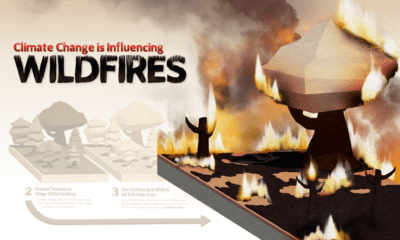
 Environment11 months ago
Environment11 months agoExplained: The Relationship Between Climate Change and Wildfires
More carbon in the atmosphere is creating a hotter world—and gradually fueling both climate change and instances of wildfires.
-
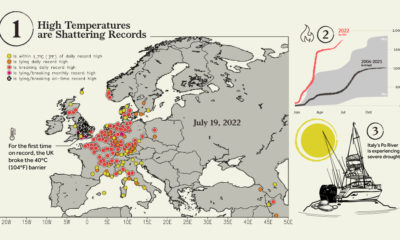
 Environment12 months ago
Environment12 months ago5 Things to Know About Europe’s Scorching Heatwave
Smoldering temperatures are wreaking havoc across Europe. Here are 5 key things you should know about Europe’s current heatwave.
-

 Energy3 weeks ago
Energy3 weeks agoHow Big is the Market for Crude Oil?
-
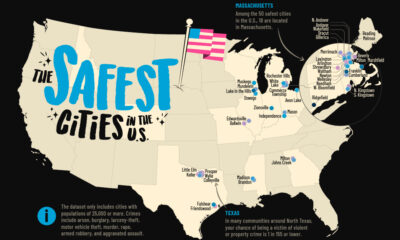
 Crime7 days ago
Crime7 days agoMapped: The Safest Cities in the U.S.
-
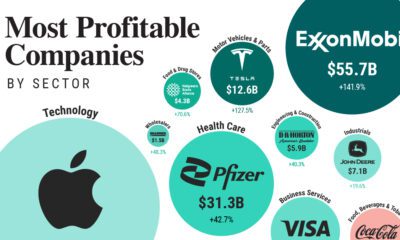
 Markets2 weeks ago
Markets2 weeks agoRanked: The Most Profitable U.S. Companies, by Sector
-

 apps5 days ago
apps5 days agoHow Long it Took for Popular Apps to Reach 100 Million Users
-

 Markets4 weeks ago
Markets4 weeks agoThe World’s Biggest Mutual Fund and ETF Providers
-

 Markets2 weeks ago
Markets2 weeks agoBrand Reputations: Ranking the Best and Worst in 2023
-

 Environment5 days ago
Environment5 days agoHotter Than Ever: 2023 Sets New Global Temperature Records
-

 Datastream4 weeks ago
Datastream4 weeks agoCan You Calculate Your Daily Carbon Footprint?




